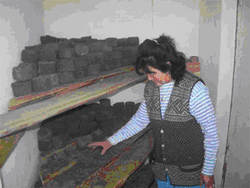Development of extension system and improvement of the fuel block utilizing livestock droppings and waste coal powder in Mongolia
Description
Mongolian nomads traditionally use the droppings of large livestock, aside from wood, as fuel materials. But, as the number of livestock decreased in 2000 and 2001 due to cold weather damage, fuel scarcity occurred due to the shortage of the fuel material. And, widespread deforestation occurred due to the illegal cutting of trees for use as fuel source. Therefore, other supply resources for fuel material are needed. In addition, to increase the income of the nomads, the manufacture of the fuel block which utilizes large livestock droppings, coal powder and saw dust for trading in the market is suggested. But, the fuel block is not acceptable in the market due to its unstable quality and insufficient technology. Consequently, improvement of the fuel block as well as development of an extension system for its distribution are needed.
To increase the fuel block production, small animal droppings were substituted for the large livestock droppings which have become limited in availability as raw materials. The fuel block technology was improved by mixing with industrial waste coal powder and adding of cow droppings as adhesive. The remaining coal powder which can not be used up by the boiler is generated as industrial waste at 20 – 30% of total coal weight. The ideal compounding ratio of the small animal droppings and coal powder was determined to be 4,500 kcal/kg, since the gel stove in Mongolia has an average heat resistance performance of 5,000 kcal/kg.
To construct the fuel block with stable and suitable quality, a manual and introductory video of its manufacturing technology were created, and the distribution was carried out by the prefectural administration to residents in the districts and to the nomads. Then, the government devised a system wherein it provides the nomads with coal powder gratuitously and also purchases the fuel blocks directly. In the meantime, it became necessary to scrutinize the prices of fuel blocks in the area and to set up appropriate selling prices. This direct purchasing of the fuel blocks by the government resulted in demand only for small size storage spaces of the fuel block for self-sufficiency and the nomads no longer need large storage spaces. This system was introduced into the “FY 2009 Socio-Economic and Community Development Basic Plan” of Uvurkhangai Prefecture, and it is being carried out in schools in 7 villages, in a kindergarten for example, etc.
This system provides incentives to the government in the form of reduction in the amount of coal use since recycling of industrial waste coal powder can be implemented; improvement in the nomads’ income and as countermeasure against illegal cutting of trees for use as fuel material resulting in forest preservation leading to environmental conservation.
Figure, table
-
Fig.1 Fuel block technology dissemination system concept -
- Photo. 1 Before fuel block introduction
-
Photo. 2 After fuel block introduction -
Changes before and after the introduction of the system
Fig. 2 Uvurkhangai Aimag/Prefecture "FY 2009 Socio-Economic and Community Development Basic Plan"
Benefits for Nomads: 1) Income augmentation with an average of 20,000 TG, and 2) Stable maintenance of fuel supply.
Benefits for the Government/Administration: 1) Wood purchase expenses reduction of 120,000 TG/month (kindergarten) and 2) Reduction of coal powder disposal expense.
- Affiliation
-
Japan International Research Center for Agricultural Sciences Rural Development Planning Division
- Classification
-
Technical B
- Term of research
-
FY2008(FY2006~2011)
- Responsible researcher
-
KIMURA Kenichiro ( Rural Development Planning Division )
MATSUMOTO Takeshi ( Rural Development Planning Division )
- ほか
- Publication, etc.
-
Japan International Research Center for Agricultural Sciences (2009) 黄砂発生源対策のための牧民参加による放牧地マネージメント計画策定手法の開発報告書.
- Japanese PDF
-
2008_seikajouhou_A4_ja_Part1.pdf652.39 KB




